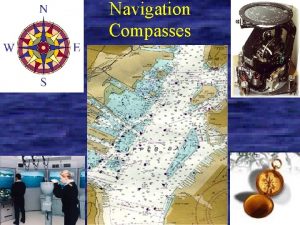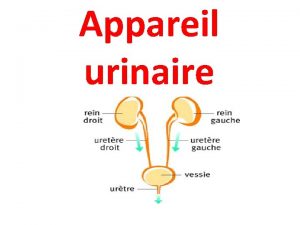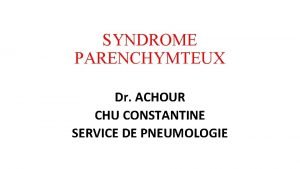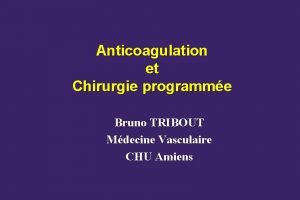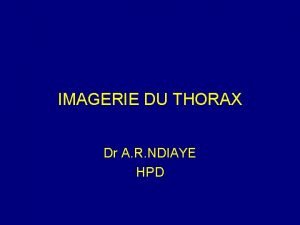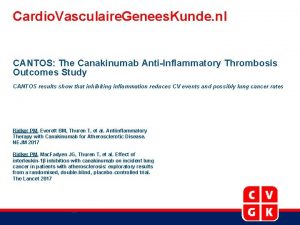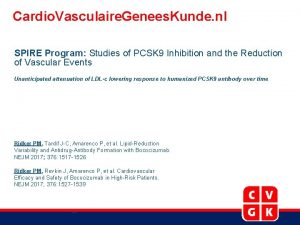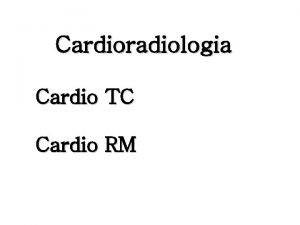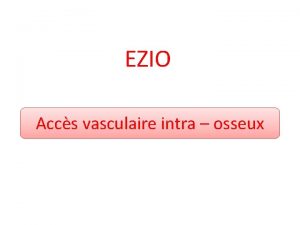Cardio Vasculaire Genees Kunde nl COMPASS Cardiovascular Outcomes






- Slides: 6

Cardio. Vasculaire. Genees. Kunde. nl COMPASS: Cardiovascular Outcomes for People Using Anticoagulation Strategies Low dose NOAC plus aspirin improve outcomes in stable cardiovascular disease compared with aspirin alone Eikelboom JW, Connolly SJ, Bosch J, et al. Rivaroxaban with or without Aspirin in Stable Cardiovascular Disease. NEJM 2017

COMPASS: Background and Objective Background • • 5 -10% of patients with cardiovascular disease suffer recurrent events, although they receive secondary prevention therapies Anticoagulation is not a recommended routine therapy for these patients Study objective The COMPASS study was designed to assess, whether rivaroxaban alone or in combination with aspirin is more effective than aspirin alone for secondary cardiovascular prevention. Eikelboom JW, et al. NEJM 2017

COMPASS: Study design 27, 395 patients with stable AVD Rivaroxaban 2, 5 mg TD plus Rivaroxaban 5 mg TD Aspirin 100 mg OD Median follow-up: 23 months Primary endpoint: composite of nonfatal MI, non-fatal stroke, and CV death The study was stopped due to superiority of the rivaroxaban plus aspirin group AVD: atherosclerotic vascular disease; TD: twice daily; OD: once daily; MI: myocardial infarction; CV: cardiovascular; Eikelboom JW, et al. NEJM 2017

COMPASS: Main results (1/2) Primary outcome: CV death, stroke, MI 6. 00% 5. 40% 4. 90% 5. 00% Major bleedings 3. 50% 3. 10% 2. 80% 3. 00% 4. 10% 2. 50% 4. 00% 1. 90% 2. 00% 3. 00% 1. 50% 2. 00% 1. 00% 0. 50% 0. 00% Major bleeding Primary outcome R + A (N=9, 152) R (N=9, 117) A (N=9, 126) HR; 95%CI; P value R + A vs. A 0. 76; 0. 66 -0. 86; P<0. 0001 R + A vs. A 1. 70; 1. 40 -2. 05; P<0. 0001 R vs. A 0. 90; 0. 79 -1. 03; P=0. 12 R vs. A 1. 51; 1. 25 -1. 84; P<0. 0001 CV: cardiovascular; MI: myocardial infarction; R: rivaroxaban; A: aspirin; HR: hazard ratio; CI: confidence interval; Eikelboom JW, et al. NEJM 2017

COMPASS: Main results (2/2) Net clinical benefit: CV death, stroke, MI, major bleedings 7. 00% 5. 90% 6. 00% 4. 70% 5. 00% 4. 00% 3. 00% 2. 00% 1. 00% 0. 00% Net clinical benefit R + A (N=9, 152) A (N=9, 126) HR; 95%CI; P value R + A vs. A 0. 80; 0. 70 -0. 91; P=0. 0005 CV: cardiovascular; MI: myocardial infarction; R: rivaroxaban; A: aspirin; HR: hazard ratio; CI: confidence interval; Eikelboom JW, et al. NEJM 2017

COMPASS: Conclusions • Rivaroxaban 2. 5 mg twice daily plus aspirin 100 mg once daily reduce the risk of CV death, stroke, and myocardial infarction, and increase major bleedings compared with aspirin alone, thus, providing a net clinical benefit for stable patients with atherosclerotic vascular disease. • Rivaroxaban monotherapy leads to less cardiovascular outcomes, and to significantly higher rates of major bleeding, compared with aspirin monotherapy. Eikelboom JW, et al. NEJM 2017

